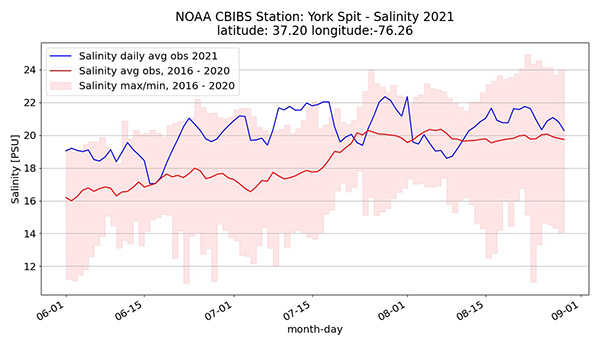Scientists at the NOAA Chesapeake Bay Office and our partners at NOAA CoastWatch compile data about key measurements in the Chesapeake Bay at the end of each season. These include data from the NOAA Chesapeake Bay Interpretive Buoy System as well as maps derived from satellite observations. NOAA scientists then analyze how these measurements may compare with the long-term average and explore what those deviations may mean for key Bay fishery species.
Overall, meteorological summer (June-August) 2021 featured:
- Roughly average water temperature;
- Dissolved oxygen levels at or below average;
- Lower than average freshwater flow from rivers; and
- Higher than average salinity in some locations.
Summer water temperatures can harm key fishery species in the Chesapeake Bay if they get too warm. For example, striped bass are a treasured species. But even catch-and-release fishing can cause mortality during warmer periods, when fish are extra stressed. And underwater grasses, like the eelgrass juvenile crabs like to use as places to hide from predators, can experience more significant die offs if water temperatures get too hot too quickly. With the roughly average water temperatures this year, fish and grasses likely did not experience increased challenges.
.jpg)
Satellite data and analysis from NOAA CoastWatch show that overall, water temperatures in the Chesapeake were near average this summer.
Having enough dissolved oxygen in the water is important for the survival of fish and other species. But often in summer, large areas of the Chesapeake experience hypoxic conditions—severely low levels of oxygen. This can make for extra challenges for fish, who try to escape higher water temperatures near the surface, by spending time lower in the water column. Essentially, the volume of water in which they can live shrinks between the too-warm surface waters and too-little-oxygen bottom waters. Scientists refer to this as a “habitat squeeze.”
In 2021, the average to below-average hypoxic volume in the Chesapeake likely was a good match for juvenile spot. These fish prefer dissolved oxygen levels between 2.2 and 3.2 mg/L. Spot are an important food for predators like striped bass.
Overall, the Chesapeake saw salinity levels that were higher than average. Salinity decreased a bit from late July to early August. This was likely due to the periods of heavy rainfall from the remnants of a few tropical storms that passed through our area. Higher salinity can support greater oyster reproduction—but also increased disease prevalence and intensity. We will learn more about how juvenile oysters fared when the Maryland Department of Natural Resources releases their fall oyster survey later this year.

Salinity at the NOAA CBIBS York Spit buoy was higher than average from June through late July, then dipped below average a bit in early August before rebounding to above average.
For more information on summer conditions and how they may have affected living resources in the Chesapeake Bay, see the full scientific seasonal summary.


